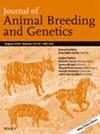开始还是不开始——瑞典温血马的遗传学问题?
摘要
瑞典温血马(SWB)的育种目标是培养具有盛装舞步和障碍赛国际竞争力的马匹。在目前的遗传评估中,育种价值是在多性状动物模型中估计的,其中竞争表现是目标性状,两种不同的小马测试结果作为指标性状。然而,在目前的评估中不考虑对马的预选,无论是为小马测试还是为比赛。本研究的总体目的是分析在竞赛和幼马试验中全或无性状的启动状态,以便可能用于SWB的遗传评估。早在1973年就记录了所有幼马测试中的起跑情况,而比赛中的起跑情况从2007年起就知道了。因此,研究人群仅限于2003年至2018年之间出生的SWB马,这些马有可能在2007年至2022年期间参加比赛。马根据他们的父亲和祖父的学科类别分为四个学科,只有两个主要类别的马,盛装舞步和障碍,被包括在这项研究中。总共有23125匹跳马和14470匹盛装舞步马被分别研究。有关障碍赛或盛装舞步比赛中特定学科的起跑状况、幼马测试(YHT)和骑马测试(RHT)的信息,以及终身累积的比赛积分、YHT和RHT评估的步态和跳跃特征。参赛马中,有31%参加过YHT, 10%参加过RHT, 56%参加过障碍赛。在盛装舞步比赛中,YHT参赛率为35%,RHT参赛率为11%,盛装舞步参赛率为34%。采用阈值和线性动物模型进行遗传分析。与未参加YHT或RHT的马匹相比,参加过YHT或RHT的马匹的竞争程度更大,平均比赛积分更高。使用阈值模型估计比赛中起跑状态的遗传率,障碍赛为0.48,盛装舞步为0.39。利用线性模型估计,在可观测的0/1尺度上,起跑状态的遗传率为0.30,在转换为底层连续尺度时,遗传率为0.47。对于盛装舞步的起跑状态,相应的遗传力估计分别为0.20和0.34。用线性模型估计,障碍赛起跑状态与YHT和RHT的跳跃性状之间的遗传相关性较强(0.78 ~ 0.93),盛装舞步比赛起跑状态与YHT和RHT的步态性状之间的遗传相关性较强(0.46 ~ 0.88)。起跑状态与比赛累积积分的遗传相关性较强,障碍赛和盛装舞步分别为0.93和0.86。利用线性模型,在可观测尺度上,对幼马启动状态的遗传力估计范围为0.07 ~ 0.42,在转换为潜在连续尺度后,遗传力估计范围为0.11 ~ 0.71。在比赛成绩的育种值估计中加入起始状态对种马排名有一定影响,提高了种马育种值的准确性。我们的结论是,启动状态是一种遗传性状,可以包括在SWB马的遗传评价中。The breeding goal of the Swedish Warmblood horse (SWB) is to produce internationally competitive horses in dressage and show jumping. In the current genetic evaluation, breeding values are estimated in multiple-trait animal models where competition performance is the target trait and results from two different young horse tests serve as indicator traits. However, preselection of horses, both for young horse tests and for competitions, is not considered in the current evaluation. The overall aim of this study was to analyse the all-or-none trait start status, in competition and in young horse tests, for possible use in the genetic evaluation for SWB. All starts in young horse tests have been recorded since long (1973), whereas start status in competition is known from the year 2007 and onwards. Therefore, the studied population was restricted to SWB horses born between 2003 and 2018 that had the possibility to compete during the period from 2007 until 2022. Horses were categorised into four disciplines according to their sire's and grandsire's discipline categories, and only horses in the two major categories, dressage and jumping, were included in this study. In total, 23,125 jumping horses and 14,470 dressage horses were studied separately. Information on discipline-specific start status in show jumping or dressage competitions, young horse test (YHT) and riding horse test (RHT) was available as well as lifetime accumulated competition points, assessed gaits and jumping traits from YHT and RHT. Out of the jumping horses, 31% had participated in YHT, 10% in RHT and 56% in show jumping competition. For dressage horses, the participation rates were 35% for YHT, 11% for RHT and 34% for dressage competition. The genetic analyses were performed with threshold and linear animal models. Horses that had participated in YHT or RHT had competed to a larger extent and had a higher mean of competition points than horses that had not participated in YHT or RHT. The heritability for start status in competition was estimated using a threshold model at 0.48 for show jumping and 0.39 for dressage. Using linear models, the heritability for start status in show jumping was estimated to be 0.30 on the observable 0/1-scale and 0.47 when transformed to the underlying continuous scale. For start status in dressage, the corresponding heritability estimates were 0.20 and 0.34. Genetic correlations, estimated with linear models, were strong between start status in show jumping and jumping traits at YHT and RHT (0.78-0.93) and moderate to strong between start status in dressage competition and gait traits at YHT and RHT (0.46-0.88). The genetic correlations between start status and accumulated lifetime points in competition were strong, 0.93 for show jumping and 0.86 for dressage. Using linear models, heritability estimates for start status in young horse tests ranged from 0.07 to 0.42 on the observable scale and from 0.11 to 0.71 after transformation to the underlying continuous scale. Inclusion of start status in the breeding value estimation of competition performance affected stallion ranking somewhat and increased the accuracies of the stallions' breeding values. We conclude that start status is a heritable trait that would be possible to include in the genetic evaluation of SWB horses.

 求助内容:
求助内容: 应助结果提醒方式:
应助结果提醒方式:


